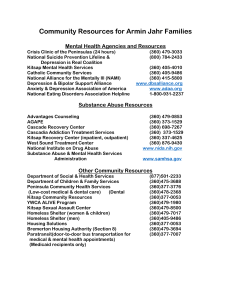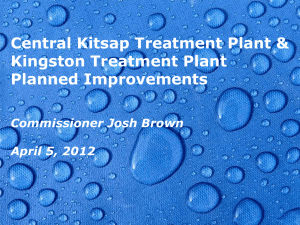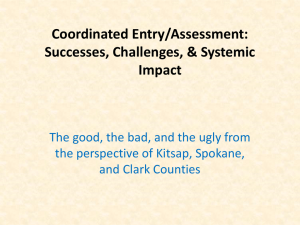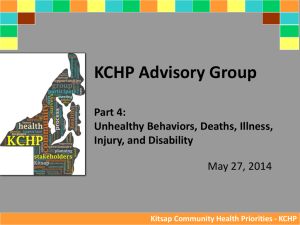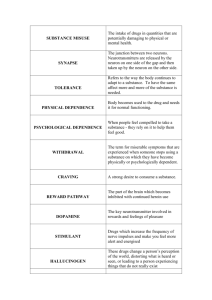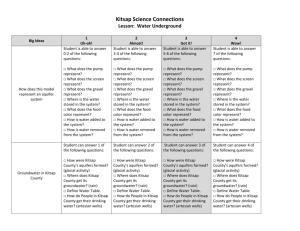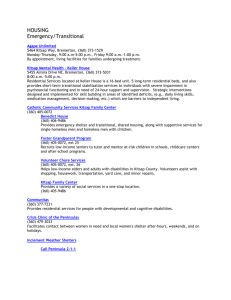Hope Center: Detoxification and stabilization facility
advertisement
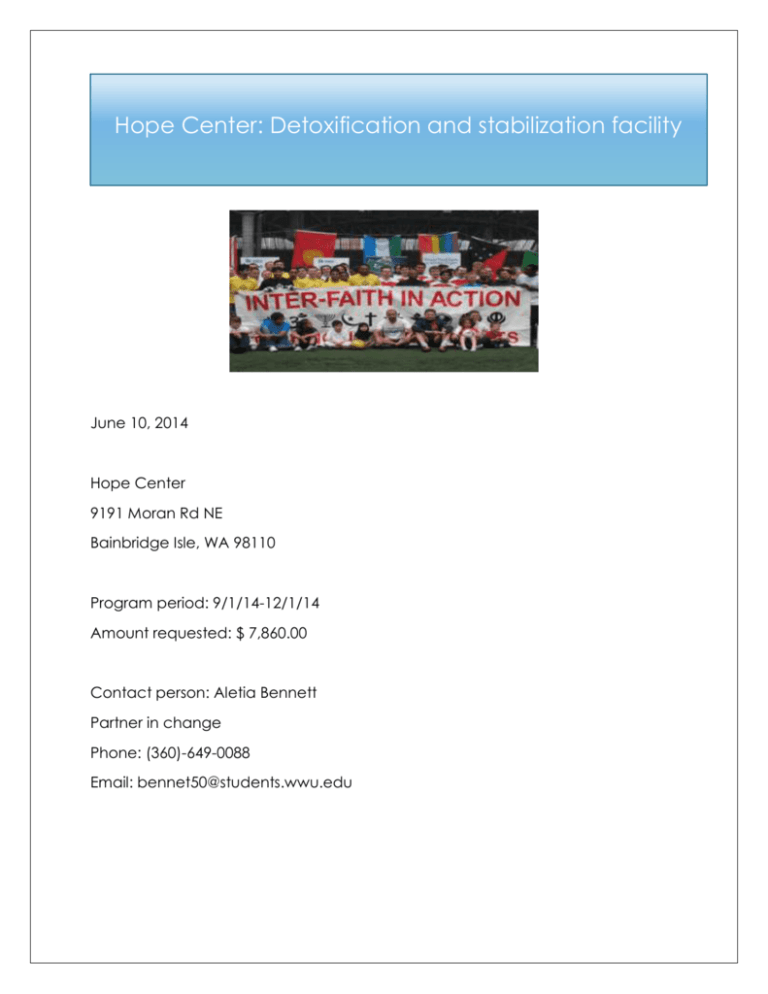
Hope Center: Detoxification and stabilization facility June 10, 2014 Hope Center 9191 Moran Rd NE Bainbridge Isle, WA 98110 Program period: 9/1/14-12/1/14 Amount requested: $ 7,860.00 Contact person: Aletia Bennett Partner in change Phone: (360)-649-0088 Email: bennet50@students.wwu.edu MASTER PROPOSAL Executive Summary At a grassroots level Hope Center is combining experts, tribal and local communities, and faith based organizations with a common mission of creating an accessible place for addicts to get stabilized prior to treatment and the ability to maintain sobriety. Hope Center is hoping to develop a culturally inclusive integrated approach to detoxification and stabilization which combines Eastern, Western, and indigenous ideologies to form a powerful and individualized treatment program. Using evidence based best practices in an integrated format our long term goal is to facilitate individual empowerment and engagement as a foundation for recovery. The need for this type of program has become increasingly urgent. The movement has already begun, as evidenced by the article in the Suquamish News entitled “Taking a Stand against Hard Drugs: Council, Police and community coordinate grassroots efforts against heroin, methamphetamines and prescription drug abuse” (Suquamish News, March 2014). We will work with culturally inclusive populations including the Suquamish tribal members to provide stabilization services for Kitsap County. We are asking you to join us and work together to develop the program and help us by providing revenues for its design strategy. Funding will provide revenues for consultant and staffing fees, training materials, travel expenses for learning experiences and training, and expenses for learning experiences and events. Our methods will include: education/training, community partnering, development of county extension council and staff, as well as evaluation measures. As a new program we will create an initial set of data based off of our results beginning the first month (12/1/14-12/31/14). Consistent incremental collection of data and strategic planning will be ongoing. The data (collected quantitatively) will provide indicators to measure the results of our objectives. As a team I believe we can combine the necessary stakeholders to reach our goal of a safe integrative place for stabilization prior to treatment. Together we can create immediate relief of the drug addiction problems facing our community. Through strategic planning in the implementation, evaluation and sustainability of the stabilization program we can address not only the immediate needs but the underlying causes of the issues of drug addiction in Kitsap County. 1 MASTER PROPOSAL Purpose/Goals Statement Our search for the most appropriate and effective treatment methods’ began with the people we are trying to save. The addicts that were interviewed said that the biggest gaps in services are in the access to stabilization and maintenance therapies. The purpose of the program is to successfully stabilize people and help them maintain sobriety from drug addiction. Our goal is to incorporate culturally inclusive and sensitive stabilization/maintenance services to increase recovery rates in our communities. By providing services KITSAP SUN individualized to the person, each individual is invested in NEWSPAPER his/her own recovery and become empowered to make THE SERIES OF the changes needed to assure recovery. STORIES CHRONICLING THE DRAMATIC RISE OF HEROIN AND OPIATE DRUGS SINCE 2008 INCLUDES: Local top cops contemplate solutions to the heroin problem IV drug use in Kitsap County surges to record levels Behind the obituary: a grieving mother mourns daughter's loss to heroin Code 911: heroin edition Methadone clinic proposed to treat growing number of addicts Heroin experiences a resurgence in Kitsap County A New Drug Scene, Ushered In Statement of Need Active drugs users who are seeking recovery from addiction, may need to be medically, spiritually, emotionally and cognitively stabilized before treatment. There are currently no drug replacement/cognitive behavioral therapy replacement and maintenance program centers or medical detoxification facilities in Kitsap County. This program will provide not only drug/cognitive behavioral therapy replacement and maintenance in addition to medical detoxification services but culturally integrated techniques to allow successful transition into drug treatment programs and long term drug recovery. In giving a voice to recovering addicts in the treatment process and easier access to services we hope to align our program with the 2013 White House drug policy “A drug policy for the 21st century: Policy 101”. In policy 101 the president promotes the expansion of national and community-based programs and early detection by health care professionals. The need for easier access to treatment while giving a voice to recovering addicts is also discussed (The White House, 2013). The Kitsap Sun newspaper in Kitsap County has been following the dramatic rise of heroin and opiate drugs since 2008 2 MASTER PROPOSAL Approach/Methods In order to achieve the objectives of Hope Center we will utilize the following methods. With the creation of a program that uses evidence based best practices and multi-cultural recovery techniques we will be combining the best known methods and inclusion of diverse ideologies to support stabilization and recovery from drug addiction. Cultural awareness and sensitivity play a key role in the diversity of the treatment types available in our program. The need and approach is widely recognized as indicated by the following: Strategic Initiative #1: Goal 1.1: With primary prevention as the focus, build emotional health, prevent or delay onset of, and mitigate symptoms and complications from substance abuse and mental illness. Creating communities where individuals, families, schools, faith-based organizations, and workplaces take action to promote emotional health and reduce the likelihood of mental illness, substance abuse including tobacco, and suicide. This Initiative will include a focus on the Nation’s high-risk youth, youth in Tribal communities, and military families (SAMHSA, 2014). “The view of addiction as a preventable and treatable disease are echoed on national and global scales.” (Office of Federal Drug Control Policy, 2013). 3 MASTER PROPOSAL When addicts come to receive stabilization treatment this is what will happen: Intake During the program •We will gather information and releases if necessary to provide services •we will create an action plan •we will coordinate the choosen treatment and correct staff as allies in the stabilization process • case workers will continually work with participants to adjust services as needed •services will be individualized to meet the needs and recovery styles of the participants •we develop post stabilization plan and next steps exit from •we will help promote self-sufficiency and self empowerment through maintainance and tracking of program postive program outcomes and follow up care Education/training In order to deliver evidence based best practices with cultural inclusion the staff will be provided training materials, travel expenses for learning experiences and training, and expenses for learning experiences and events. Job descriptions and requirements for all staff/volunteers will be determined a month in advance. Outreach/marketing Through outreach and marketing we will create awareness and education of the program for the communities and the addicts. The inclusion of community meetings, marketing materials that are accessible at many locations, contact list, and website will be available. Evaluation Plan In order to monitor program implementation quantitative data will be gathered, reviewed and adjusted according to the following indicators: number of participants served by this program number of stabilized participants entering drug treatment after stabilization services at facility number of relapses after transportation to drug treatment centers number of participants who complete treatment number of participants that relapse short term number of annual incarceration rates for drug possession 4 MASTER PROPOSAL Sustainability Sustainability of the program will be based off of evidence based best practices of sustainable organizational strategies utilizing five key elements: 1. Strategic Planning Board ((county extension council and staff) and Administration Collaboration Vision, Mission, Values Development & Alignment Short and Long Term Goals: (Specific Measurable Attainable Realistic Tangible Approach) Setting and Tracking Priorities: Track progress against goals using monthly status reporting Periodic Review: Review plan quarterly with board and staff in half day session (includes professional development) Annual Updates : Update plan annually with board and staff 2. Board (county extension council and staff) Effectiveness Governance Responsibility Board Developmen t(county extension council and staff Effective Meetings Status Reporting 3. Leadership & Administration 1. 2. 3. 4. 5. 6. Administrator Recruiting 5 MASTER PROPOSAL 4. Marketing & Communication Marketing Plan, Targeted Marketing, Messaging, Media, Public Relations, Community Engagement 5. Fundraising The expansion and diversity of funding will be an ongoing process. Initial funding opportunities will come from partners, multi-level grant writing, private contributions, In Kind, foundations and corporate donations. We will explore expansion of social entrepreneurial sources of funding also. Organizational Background The Hope Center (founded in 2000) currently provides housing, transportation to medical/treatment appointments, and case management services. The building (12,374 SF) is already in place and has the zoning required for medical services. The facility will accommodate twenty detoxification beds and a medical/alternative treatment area with a WHAT MAKES THIS PROGRAM UNIQUE IS THE separate entrance. Hope Center currently CULTURAL INCLUSION OF MULTIMODALITIES is referred by Kitsap (MEDITATION, PRAYER, CBT, NATIVE AMERICAN Mental Health, Kitsap CEREMONIES/SWEATS, ETC.) IN THE STABILIZATION Recovery Center, PROGRAM. Kitsap County Courts and the Suquamish tribe. The pursuit for consultants and partners, we will pursue relationships with Pioneer Human Services, United Way, Leadership Kitsap Foundation, current medical/drug detoxification and maintenance facilities. Additional relationships will be developed as opportunities arise; including but not limited to, community action organizations and fiscal sponsors. In providing revenues for its design strategy, the program will have a stable foundation in which to create a much needed, successful and sustainable program. 6 MASTER PROPOSAL Budget and Budget Narrative INCOME BUDGET Revenue Source Description Amount Government grants $0 Foundations $0 Corporation Sponsorship or Grants $0 United Way or other federated campaigns $0 Individual contributions (annual fund) $500.00 Fundraising events and products $0 Membership income (membership dues) $0 In-kind support Donated space, equipment, volunteer talent. $ 50,000 Earned income (tuition, fees, etc.) $0 Total Income $50,500 7 MASTER PROPOSAL EXPENSE BUDGET Expense Line Item Salaries and wages (breakdown by individual position and indicate full- or part-time.) Consultants and professional fees Travel Equipment Supplies Marketing: Printing and copying Telephone and fax Postage and delivery Utilities Insurance Training and learning experiences In-kind expense Total Expense Difference (Income less Expense) Description clerical staff= 1*2hrs*12 weeks *10.00 value of staff hour=240.00 professional staff= 1*10hrs*12 weeks *18.00 value of staff hours= 2,160.00 Consultant=2*3hrs*12 weeks*20.00 value of consultant hours=1,440.00 travel expenses for learning experiences and training, N/A training materials, office supplies Papers, flyers, invites N/A N/A electricity, heat, water and other utilities Insurance, general liability, professional liability (malpractice), meeting cancellation, and business interruption insurance. Training=3 *8hr *cost of training=$2,400.00 Learning experience=2 *10hr *cost of learning experience= $600.00 Donated space, equipment, volunteer talent Disregarding the in-kind Amount $ 2,400.00 $ 1,440.00 $ 200.00 $0 $ 600.00 $ 100.00 $0 $0 $ 120.00 $1,200.00 $3,000.00 ($50,000.00) $57,860.00 $500.00 8 MASTER PROPOSAL Here are the highlights of the revenue expenses: The in-kind support of providing the donated space, equipment and volunteer talent greatly offsets our expenses for the facility. The costs for staff and consultants for the program development are calculated on a 12 week period. Travel expenses include off-site learning experiences and trainings conducted in the Puget Sound area. The training materials and office supplies include hard copy training materials and paper, ink, and use of office equipment. In order to protect the fiscal well-being of the program development, insurance has been added to the expenses. Training and learning experiences have been broken down into orientation, specialized training, experiential learning, and assessment of future training needs. 9 MASTER PROPOSAL References Farley, J. (2011). Kitsap Sun: Heroin experiences a resurgence in Kitsap County. Bremerton WA. Retrieved from http://www.kitsapsun.com/news/2011/mar/12/heroin-experiencesresurgence-kitsap-county/#axzz2qclC5GpQ The White House, Office of Federal Drug Control Policy, Policy and Research. (2013). A drug policy for the 21st century: Policy 101. Retrieved from http://www.whitehouse.gov/ondcp/policy-and-research SAMHSA, Center for Substance Abuse Prevention. (2014). Prevention of substance abuse and mental illness. Retrieved from http://store.samhsa.gov/shin/content//SMA11-4629/03-Prevention.pdf Geagan, B. (n.d.) Charter Start Workshops: Sustainable Organizational Strategies. Boise, Idaho; Idaho State Department of education. Retrieved from http://www.sde.idaho.gov/site/charter_schools/research/School%20Boards/Sust ainable%20Organizational%20Strategies.pdf 10 MASTER PROPOSAL Suquamish News, (March, 2014). Taking a Stand against Hard Drugs: Council, Police and community coordinate grassroots efforts against heroin, methamphetamines and prescription drug abuse. Retrieved from www.suquamish.nsn.us/.../TribalNewsletters/Suquamish%20News%203- 11 MASTER PROPOSAL 12
